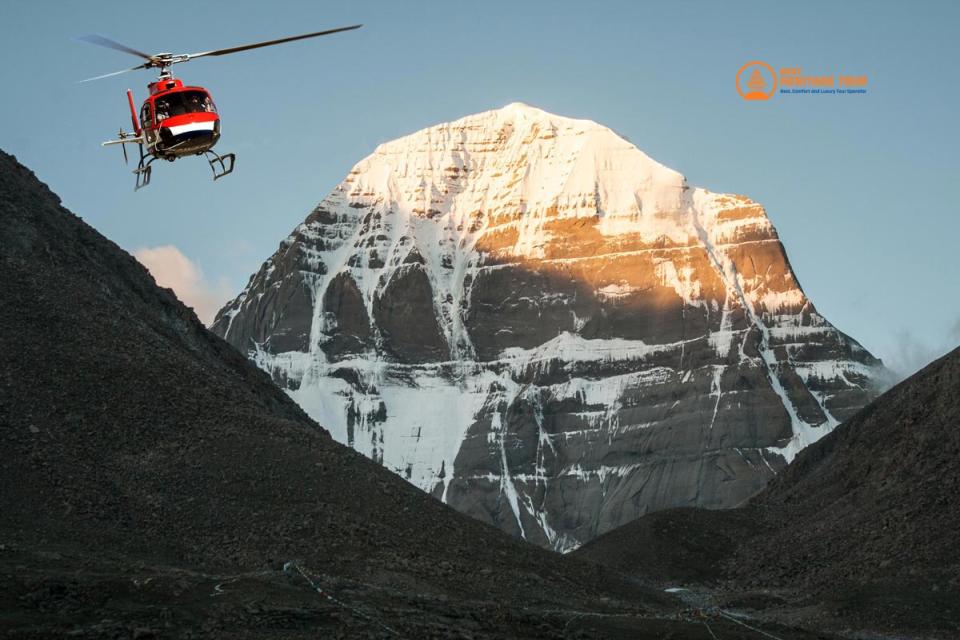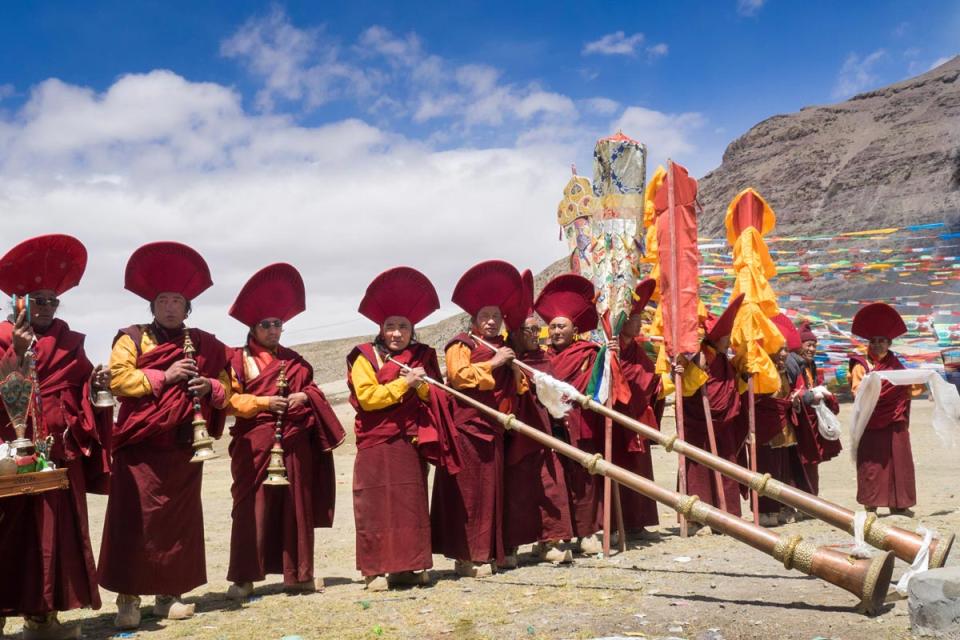The Kailash Manasarovar Yatra is not just a spiritual journey - it’s a profound exploration of culture, endurance, and the Himalayan way of life. While the stunning landscapes, sacred rituals, and the divine aura of Mount Kailash are central to the pilgrimage, one of the most frequently overlooked aspects of this extraordinary journey is the food and drink experience.
Whether you’re preparing for the trek from Kerung / Rasuwagadhi into Tibet, or simply planning your supplies, understanding the culinary landscape is essential. Meals in the high Himalayas are not just fuel - they are a source of comfort, warmth, and a glimpse into the local culture.
As a Nepali travel company with years of experience leading Kailash Manasarovar tours, Best Heritage Tour brings you an insider’s guide to everything you need to know about foods and drinks on this sacred route. From local Tibetan specialties to practical hydration strategies at high altitude, this guide will prepare you for a truly fulfilling journey.
Overview of the Kerung / Rasuwagadhi Route
The Kerung / Rasuwagadhi border serves as one of the main entry points from Nepal into Tibet for the Kailash Manasarovar Yatra. This route combines rich Tibetan culture with the challenging yet scenic terrain of the Himalayas.
Key highlights of the route include:
-
Kerung / Rasuwagadhi border crossing
-
Tingri, Saga, and Darchen stops in Tibet
-
Sacred Lake Manasarovar
-
Mount Kailash base and parikrama circuit
Along this route, the availability and type of food and drink vary based on altitude, remoteness, and local infrastructure. Pilgrims encounter a mix of Tibetan, Nepali, and Chinese cuisine, along with specialized trekking meals designed for high-altitude endurance.
Meal Patterns During the Journey
High-altitude trekking demands balanced meals with sufficient calories, protein, and hydration. On the Kerung / Rasuwagadhi route, meal schedules are generally structured as follows:
Breakfast
-
Usually served around 6:00-7:00 am
-
Options include porridge, tsampa (roasted barley flour), eggs, bread, and butter tea
-
Provides energy for morning treks and acclimatization exercises
Lunch
-
Served around 12:00-1:00 pm
-
Typically light but hearty: noodles, momos, rice with vegetables, or Tibetan thukpa (noodle soup)
-
On higher altitudes like Saga or Darchen, dehydrated or pre-packed meals may be used for efficiency
Dinner
-
Served between 6:00-7:00 pm
-
Meals often include dal bhat (lentil soup with rice), vegetables, potato dishes, and butter tea
-
Provides essential calories to withstand the cold night and maintain energy levels
Snacks and High-Energy Foods
Pilgrims are advised to carry snacks for trekking stretches:
-
Chocolate bars
-
Dry fruits and nuts
-
Energy gels
-
Biscuits or crackers
-
Instant soups
Traditional Tibetan Foods on the Kailash Route
Tibetan cuisine dominates the food experience on the Kerung / Rasuwagadhi route. These foods are specially adapted to the high-altitude climate and offer both nourishment and comfort.
a. Tsampa
-
What it is: Roasted barley flour, sometimes mixed with butter tea
-
Why it’s important: High in calories, easy to digest, perfect for early morning energy
-
How to eat: Traditionally, mixed with butter tea to form a dough-like consistency
b. Butter Tea (Po Cha)
-
What it is: Tea made from yak butter, water, and salt
-
Purpose: Provides warmth, hydration, and essential fat for energy
-
Taste profile: Salty and rich; an acquired taste for first-time travelers
c. Thukpa
-
What it is: Tibetan noodle soup with vegetables, meat, or yak chunks
-
Nutrition: High in carbs and protein, helps replenish energy lost during trekking
-
Popularity: A staple lunch or dinner choice for pilgrims
d. Momo
-
What it is: Tibetan dumplings filled with meat or vegetables
-
Serving style: Steamed or fried
-
Role in journey: Easy to digest, popular snack or light meal
e. Chang / Tibetan Beer (Optional)
-
Fermented barley drink consumed locally
-
Not commonly offered to pilgrims at high-altitude camps due to alcohol’s effect on acclimatization
Nepali Influence on the Menu
Since the Kerung / Rasuwagadhi route begins in Nepal, some Nepali staples are incorporated into meals, especially at lower altitudes:
-
Dal Bhat (lentil soup with rice): High protein and energy
-
Aloo Tama (potato and bamboo shoot curry): Comfort food for trekkers
-
Sel Roti and Chapati: Snacks for morning energy boosts
-
Tea and Coffee: Especially at rest stops before entering Tibet
This mix of Nepali and Tibetan foods creates a culturally rich dining experience for pilgrims.
High-Altitude Diet Considerations
Trekking at elevations above 4,500 meters requires careful attention to nutrition and hydration. Pilgrims often face challenges such as loss of appetite, nausea, or dehydration. Here’s what to know:
Calories
-
Pilgrims burn 4,000-5,000 calories per day
-
Meals must include complex carbs (rice, noodles, barley), protein (meat, lentils, cheese), and healthy fats (butter, yak cheese)
Hydration
-
Dehydration is a major risk at high altitude
-
Recommended drinks:
-
Warm butter tea
-
Lemon tea
-
Electrolyte water
-
Soups
-
Easy-to-Digest Foods
-
Avoid heavy, oily meals at night
-
Focus on soups, porridge, and soft vegetables
Supplements
-
Pilgrims sometimes take iron, multivitamins, or high-calorie energy bars
-
Always consult a guide or doctor before the trek
Drinking Water & Hygiene
Water safety is critical on the Kerung / Rasuwagadhi route:
-
Bottled mineral water: Widely available at Saga and Darchen
-
Boiled water: Offered at guesthouses or camps
-
Filtered water: Recommended for trekkers who carry portable purifiers
-
Avoid untreated river water
Hygiene is equally important:
-
Hand sanitizers are recommended
-
Use boiled or bottled water for brushing teeth
-
Avoid ice or raw salads at higher altitudes
Food at Key Stops Along the Route
Here’s a day-by-day food and drink guide along the Kerung / Rasuwagadhi route:
Kerung / Rasuwagadhi
-
Meals: Simple Tibetan or Nepali-style meals at local lodges
-
Drinks: Tea, coffee, and warm water
-
Tips: Carry snacks, as border crossing can be delayed
Saga
-
Meals: Tibetan thukpa, tsampa, momos, rice dishes
-
Drinks: Butter tea and warm soup
-
Tips: Focus on hydration and high-calorie intake
Darchen
-
Meals: Dal bhat, vegetable curries, yak meat dishes
-
Drinks: Butter tea, warm lemon water
-
Tips: Prepare for Kailash parikrama; moderate heavy foods
Parikrama / Kora
-
Meals: Packed meals or simple camp food
-
Drinks: Boiled water, tea, energy drinks
-
Tips: Carry dry fruits and nuts for energy during long trekking stretches
Lake Manasarovar
-
Meals: Rice, lentils, and local Tibetan offerings
-
Drinks: Mineral water, tea, and soups
-
Tips: Keep meals light, avoid overhydration immediately before altitude climbing
Dietary Recommendations for Pilgrims
-
Eat small, frequent meals to maintain energy
-
Include carbs, protein, and fat in every meal
-
Drink warm fluids to combat cold and dehydration
-
Avoid alcohol and excess caffeine
-
Carry snacks for remote stretches
-
Listen to your body - altitude can suppress appetite
Food for Special Needs
Best Heritage Tour ensures meals are flexible for:
-
Vegetarians: Dal bhat, rice, noodles, vegetable momos
-
Vegans: Limited, but achievable with rice, vegetables, and barley flour
-
Non-Spicy Preferences: Tibetan cuisine is naturally mild
-
Gluten-Free: Rice, buckwheat, and tsampa are gluten-free options
Insider Tips from Local Guides
-
Try tsampa at least once a day for energy
-
Butter tea in small amounts helps with hydration and warmth
-
Eat porridge early morning before trekking to aid digestion
-
Avoid heavy meat dishes the day before long trekking stretches
-
Snacks like dry fruits and energy bars are lifesavers during high-altitude sections
-
Respect local dining customs: don’t waste food, share when offered
Cultural Significance of Food & Drink
Food in the Kailash region is more than sustenance; it is deeply connected to spiritual rituals:
-
Pilgrims often offer food to local deities before the parikrama
-
Butter tea is used in ceremonial offerings
-
Meals at monasteries or local homes reflect Tibetan hospitality
-
Sharing a simple meal with fellow pilgrims builds a sense of community and spiritual bonding
Packing Tips for Foods & Drinks
For the Kerung / Rasuwagadhi route, pilgrims should carry:
-
Snacks: Nuts, energy bars, chocolate
-
Tea bags, instant coffee, or soup packets
-
Water purification tablets or portable filters
-
High-calorie supplements if recommended by guides
-
Small thermos or water bottle for trekking
Emergency Food & Altitude Considerations
Sometimes weather or border delays can affect food availability. Though Best Heritage Tour provide a proper cook with enough food, it better to always keep:
-
Extra instant noodles or porridge packs
-
Electrolyte powder for hydration
-
Packaged high-calorie bars
High-altitude fatigue and AMS can be mitigated by staying well-fed and hydrated, making food one of the most critical components of a successful pilgrimage.
Final Thoughts: A Culinary Journey at the Roof of the World
Traveling the Kerung / Rasuwagadhi route for the Kailash Manasarovar Yatra is more than spiritual or scenic - it is a culinary adventure. The combination of Tibetan staples, Nepali influences, high-altitude nutrition, and local hospitality provides an unforgettable gastronomic experience.
Every cup of butter tea, every bowl of thukpa, every bite of tsampa carries not just energy, but the essence of Himalayan culture, endurance, and spirituality. For pilgrims, food and drink are not just survival-they are part of the journey, the bonding, and the sacred experience.
Plan Your Kailash Manasarovar Yatra with Best Heritage Tour
For an organized, safe, and authentic Kailash Manasarovar pilgrimage via the Kerung / Rasuwagadhi route, contact Best Heritage Tour today:
Phone / WhatsApp / Viber: +977-9851149197 / +977-9810043046
Email: info@bestheritagetour.com / bestheritagetour@gmail.com
Website: www.bestheritagetour.com
Office: Thamel Marg, Kathmandu, Nepal
Embark on a sacred journey, savor the Himalayan flavors, and create memories that last a lifetime.
Author: Best Heritage Tour
Date: 23rd November, 2025





